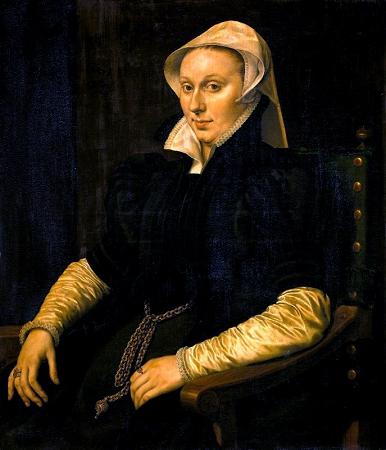Anthonis Mor (c1517 - 1577). Sir Anthonis Mor, also known as Anthonis Mor van Dashorst and Antonio Moro, was a Netherlandish portrait painter, much in demand by the courts of Europe. He has also been referred to as Antoon, Anthonius, Anthonis or Mor van Dashorst, and as Antonio Moro, Anthony More, etc., but signed most of his portraits as Anthonis Mor. Mor developed a formal style for court portraits, largely based on Titian, that was extremely influential on court painters across Europe, especially in the Iberian Peninsula, where it created a tradition that led to Diego Velįzquez. It can include considerable psychological penetration, especially in portraits of men, but always gives the subject a grand and self-possessed air. Mor was born in Utrecht, Netherlands, by some estimation between 1516 and 1520. Little is known about his early life, except that his artistic education commenced under Jan van Scorel. His earliest known work is a portrait which is now in a collection in Stockholm, dated 1538. A group of Knights of St. John at Utrecht, supposed to have been painted about 1541; and a picture of two pilgrims at the Gemäldegalerie, Berlin, dated 1544; and the portrait of an unknown woman, in the Lille gallery, were probably among his earliest works, although their authenticity has not been proven. In 1547 Mor was received as a member of the Venerable Guild of St. Luke at Antwerp, and shortly afterwards he attracted the attention of Cardinal Granvelle, Bishop of Arras, who became his steady patron. Of the portraits executed during the early period of his career as Granvelle's protege, two are especially notable: one of the bishop himself, and one of the Duke of Alba, which now belongs to the Hispanic Society of New York. Between 1549 and 1550 Prince Philip II of Spain traveled around the Netherlands to present himself as the future ruler. Mor painted his portrait in Brussels in 1549. He probably visited Italy, where he copied some works by Titian, notably the Danaė. In the middle of 1550 Mor left for Lisbon with a commission from Mary of Hungary to portray the Portuguese branch of the family. Mor probably traveled via Valladolid, where he painted the portraits of Maximilian II and his wife Maria of Austria, their daughter Anna and the son of Philip, Don Carlos. In Lisbon, Mor portrayed King Joćo, Queen Catharina, Prince Joćo and Philip's future wife, Princess Maria of Portugal. Little more is known about Mor's stay in Portugal, but he was definitely back in Brussels by November 1553. After the sudden death of the king of England, Edward VI, in July 1553, the Spanish king Charles V now saw the possibility of an alliance between Spain and England. The engagement between Philip and his Portuguese princess was broken and negotiations started for a marriage with the successor to the English throne, Mary Tudor. During these negotiations, Mor was sent to England to paint a portrait of Mary, but the exact date of the painting is unknown. This portrait was much appreciated in England and Mor made at least three versions, which became much the best-known likeness of the queen. On 20 December 1553, Philip officially appointed Mor as painter in his service. In October 1555, Charles V abdicated from the throne. During the ceremonies and festivities surrounding the coronation of his son Philip as king of Spain, Mor would have received many commissions for paintings. Unfortunately, many of these paintings are lost or only known through copies. Mor was very productive after Philip's ascension to the throne, and produced some of his most important portraits in this period, such as the portrait of Prince William I of Orange, the portrait of Alessandro Farnese and a new portrait of Philip II. Other important works from this period include the portrait of Jane Dormer, the portraits of Jean Lecocq and his wife, and the portrait of Jan van Scorel, which was at a later time to be hung at his tomb and now belongs to the Society of Antiquaries. Following the death of Mary Tudor in 1558, King Philip was remarried in June 1559 to Isabella de Valois, whom Mor portrayed ca. 1561. This portrait appears to have been lost. Also from this period dates the only known self-portrait of Mor, now in the Uffizi Gallery, and one of his wife, now in the Prado. It seems likely that Mor accompanied King Philip on his return to Spain in 1559. That Mor stayed at the Spanish court is confirmed by the letters which Philip regularly sent to Mor after he had left again in 1561. In his letters, Philip requested Mor's return to court several times, but the painter never complied with his repeated requests. Among the works which Mor supposedly painted in Spain are the Portrait of Juana of Austria and the Portrait of Don Carlos.
more...













